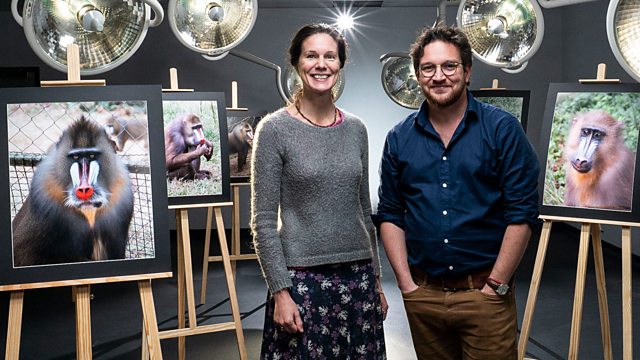Secrets of Skin episode 4 – Communication: Why are male mandrill faces (big bold primates from West Africa) red and blue? How are birds’ feathers so colourful? What do ringtail lemurs do to talk to one another? Their skin holds the key. As Professor Ben Garrod explores how animals communicate with one another, he uncovers a myriad more wonderful ways.
Skin has evolved in some remarkable ways to enable animals to communicate with each other, from vibrant displays of colour to skin pouches to amplify sound. Ben shows how animals have evolved to use skin to make themselves heard loud and clear. Birds are notable for their use of coloured feathers to attract mates, show status and as displays of aggression. But, as Ben discovers, long before birds evolved their unrivalled use of colour, it is now believed that their ancestors, the dinosaurs, could well have been using colour to communicate. Ben also uncovers how one species of fish communicates using electricity, and a common British bird has been secretly communicating for years, without us ever knowing.
Featuring groundbreaking new science, experiments and leading scientists from a variety of disciplines, the series unravels the natural history of the body’s largest organ.
Secrets of Skin episode 4 – Communication
Skin is the layer of usually soft, flexible outer tissue covering the body of a vertebrate animal, with three main functions: protection, regulation, and sensation. Other animal coverings, such as the arthropod exoskeleton, have different developmental origin, structure and chemical composition. The adjective cutaneous means “of the skin” (from Latin cutis ‘skin’). In mammals, the skin is an organ of the integumentary system made up of multiple layers of ectodermal tissue and guards the underlying muscles, bones, ligaments, and internal organs.
Skin of a different nature exists in amphibians, reptiles, and birds. Skin (including cutaneous and subcutaneous tissues) plays crucial roles in formation, structure, and function of extraskeletal apparatus such as horns of bovids (e.g., cattle) and rhinos, cervids’ antlers, giraffids’ ossicones, armadillos’ osteoderm, and os penis/os clitoris.
All mammals have some hair on their skin, even marine mammals like whales, dolphins, and porpoises that appear to be hairless. The skin interfaces with the environment and is the first line of defense from external factors. For example, the skin plays a key role in protecting the body against pathogens and excessive water loss. Its other functions are insulation, temperature regulation, sensation, and the production of vitamin D folates. Severely damaged skin may heal by forming scar tissue. This is sometimes discoloured and depigmented. The thickness of skin also varies from location to location on an organism. In humans, for example, the skin located under the eyes and around the eyelids is the thinnest skin on the body at 0.5 mm thick and is one of the first areas to show signs of aging such as “crows feet” and wrinkles. The skin on the palms and the soles of the feet is the thickest skin on the body as 4 mm thick. The speed and quality of wound healing in skin is promoted by the reception of estrogen.




